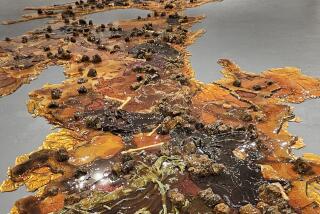Sculpting his steely vision
IS Richard Serra Americaâs greatest living sculptor? As his massive steel abstractions have risen from Bilbao, Spain, to San Francisco, many critics have come to think so. Best known for curvilinear structures with vertiginously tilting walls, he carves out great swaths of space in compelling forms that exude dangerous beauty.
But there hasnât been much evidence of his status in Southern California.
Nearly eight years have passed since a spectacular exhibition of his âTorqued Ellipseâ series created a sensation at the Museum of Contemporary Art in Los Angeles. Caltech planned to acquire an undulating steel wall by Serra, with funds from philanthropist Eli Broad, but scrapped the idea in response to students who viewed the proposed artwork as an unwanted barrier.
âI havenât been too present there,â Serra said, choosing his words carefully when reached by telephone at his New York studio.
That situation is changing fast. âT.E.U.C.L.A.,â his first public sculpture in Southern California, was installed a couple of weeks ago in the plaza of UCLAâs Eli and Edythe Broad Art Center, to open Sept. 13. Funded by the Broads, who contributed $23.2 million to the art complex, the 42.5-ton work is a twisted, cylindrical enclosure comprising two 14-foot-tall steel plates.
And two other Serras are on the way. The Orange County Performing Arts Center in Costa Mesa will install a 66-foot-tall tower on its plaza in mid-April. The Museum of Contemporary Art San Diego has ordered an assembly of six forged steel blocks for its expanded downtown facility, adjacent to the historic Santa Fe train station. That work is scheduled to go on permanent view in early June.
Together, the three public pieces will offer a multifaceted view of an artist who established himself in the 1960s and has dominated American sculpture for more than a decade. The Museum of Modern Art in New York will issue its official stamp of approval in 2007 with a sprawling retrospective exhibition -- his second at MoMA.
*
A long-running series
A force in person as well as in art, Serra, 66, customarily keeps a close watch over each new work. A knee replacement, done about two months ago, prevented him from traveling to Los Angeles for the UCLA project, but he plans to come to California when the other two sculptures are put in place.
âIâve never missed the installation of a big piece,â he said. âI would have been there if I could. Iâm walking, but there was no way I could get on a plane, and Iâm not allowed to walk for more than 20 minutes at a time.â
âT.E.U.C.L.A.â is part of the âTorqued Ellipseâ series, which began in 1996 as single elliptical forms. Made of huge steel plates bent into circular sculptures with open tops, they rotate upward as they lean in or out. Viewers enter through gaps between edges of the plates, but the works are so large that it is impossible to grasp the entire structure from a single vantage point. As the series evolved, Serra began to combine curved forms in âDouble Torqued Ellipsesâ that lead viewers around a walled walkway and into a circular opening.
âSome of the pieces were involved with a âTorqued Ellipseâ within a âTorqued Ellipse,â â he said. âThen, as they got more complex, they even became spirals where the center drifted, so when you were walking through them you didnât know where you were going.â
For UCLA, he kept the project relatively concise in a âsingleâ thatâs similar to works at the Guggenheim Museum Bilbao and the Dia Art Foundationâs facility in Beacon, N.Y.
âI thought I could make one that would say what I wanted to say in the most simple, abstract way,â Serra said. âThis piece is one of the prime movers of the whole series. It sets up the parameters of how the series spins out. Once you understand how this piece works formally when you walk inside -- that the walls are leaning toward you or away from you, and from the outside you canât discern that -- you realize that the more complex pieces started with a very reduced idea. The singles are where it started.
âOne piece at Dia is probably as abstract as this,â he said, âbut I thought I could make this one better. Thatâs why I did it. Basically, your work comes out of your work, and you have to analyze your work to know which move to make. I think thatâs how it goes for everyone.â
The plaza of the Broad Center, designed by architect Richard Meier, is bordered by buildings on the north and west, a walkway on the east and the universityâs sculpture garden on the south. Serra selected a spot where his work can be seen close up and from a distance.
âTo be able to place a piece of that kind in a public space is rare,â he said of the university art-department setting. âIt will have an in-built audience of people who are interested in art,â he said, âand thatâs very gratifying.â
The Orange County tower was funded by Henry Segerstrom, founding chairman of the performing arts center, and his wife, Elizabeth. Serra designed it as the centerpiece of a plaza connecting the existing performing arts facility with the new Segerstrom Center for the Arts. The new building will accommodate a concert hall, to open in September, and an art museum, planned for the future.
âIt has five plates that bend and lean as they go up,â Serra said of the soaring sculpture. âItâs about 66 feet high, over 20 feet at the bottom, and it leans into a space about 5 feet across at the top. As it rises, it rotates about 17 degrees. So you are in a space that rotates, rises and compresses. There are two openings between the plates where you can walk in and exit. One opening is set on line with the new arts center; the other is set on line with a roundabout. The piece is placed right at the end on the center line of the plaza, in front of whatâs going to be a museum. I hope it will collect space, like a campanile.â
The tower is similar to the UCLA piece in material and ambition, but it is not a âTorqued Ellipse,â Serra said. âThe only thing closely related to it is an indoor piece called âCharlie Brownâ at the Gap headquarters at the Embarcadero in San Francisco,â he said. âItâs also about 60 feet high, but it only has four plates and thereâs only one entrance. The space inside is only 10 or 12 feet across. Once I had the possibility of building that kind of work outside, I thought I could take a bigger stride. The piece in Orange County is much grander in its accessibility.â
*
Playing with steel blocks
THE San Diego work will have a prominent place on an arched concourse at the downtown train station. Museum supporters Sue K. and Charles D. Edwards donated $1 million toward the sculpture commission; the site has been named the Figi Family Concourse in honor of a $1-million gift to the museumâs expansion campaign from J. Todd Figi.
âThatâs a piece made of six forged blocks,â Serra said, launching into a description of his third Southern California project. âEvery block is exactly the same size [52 by 58 by 64 inches]. If you have something that has a different height, width and depth, you have three different configurations if you face them. If you then rotate them, you have six different configurations. You can set one block in six different ways. There are six different permutations where the block does not look anything like the other blocks and yet the widths are all the same and the sizes are all exact.â If the process is taken to the max, he said, there are 720 possible variations.
Moving the blocks around âsets up a certain kind of cadence,â Serra said. In San Diego he chose to place each block in a position that would make it appear most dissimilar to the others and in a precise relationship to the arches.
âPeople will see the piece as they walk, they will see it from the train, and they will see it in its sequence as it moves,â he said. âIt has the rhythm of the place. I really like that site. I like the piece, and I like its concentration on that site.â Unlike a similar work that has been shown in a tighter configuration, he said, âthis is a much more open and lyrical piece. Even given its tonnage, it has much more of a speed to it; itâs much more about walking and passing by.â
Such projects canât be made single-handedly. Serraâs steel pieces are fabricated in Germany and installed by Budco, a New York-based firm with which he has worked for more than 30 years as one generation rolled into another. Joe Vilardi headed the group at UCLA and Serra makes a point of giving lots of credit to him and his associates.
âItâs a kind of glorious choreography when you watch what they do,â he said of the way they guide huge sheets of curved steel into exactly the right position. Despite his education at UC Berkeley, UC Santa Barbara and Yale University, Serra -- who was born in San Francisco in 1939 to a working-class immigrant family and did a stint at a steel company during his college years -- never forgets his roots.
âI donât know how it happened in the United States, but people working in industry have been given short shrift in terms of other professions,â he said. âPeople who rig like Joe Vilardi have nothing but my respect because they do that every day and they do it with a great amount of ingenuity and purposefulness and patience and concentration. It takes all that, and they are very, very good at what they do. Thatâs the kind of job you learn by being on the job.â
And there seems to be no shortage of work. A major Serra sculpture composed of four walk-through spherical sections was installed in a prominent position at the Toronto airport about six months ago, but it wonât go on view until construction of the terminal is finished. The UC San Francisco Medical Centerâs new Mission Bay campus also has a Serra awaiting public unveiling. Seizing an opportunity to honor a native son, Chancellor J. Michael Bishop spearheaded a drive to acquire a Serra for the main pedestrian entrance to the campus. It consists of two 60-foot-tall steel plates placed about 300 feet apart.
Yet another work, for the Massachusetts Institute of Technology, is under discussion. But at the moment, Serra is concentrating on the retrospective at MoMA. It will contain only about 20 pieces, he said, but many of them are enormous. Surveying four decades, the works will fill two floors of temporary exhibition space and spill out into the garden.
So with all that going on, whatâs he doing in his spare time?
âBasically Iâve been doing a lot of pool therapy,â he said. âI am swimming. Iâm better, but not all better. In another month, Iâll be all better.â
More to Read
The biggest entertainment stories
Get our big stories about Hollywood, film, television, music, arts, culture and more right in your inbox as soon as they publish.
You may occasionally receive promotional content from the Los Angeles Times.










